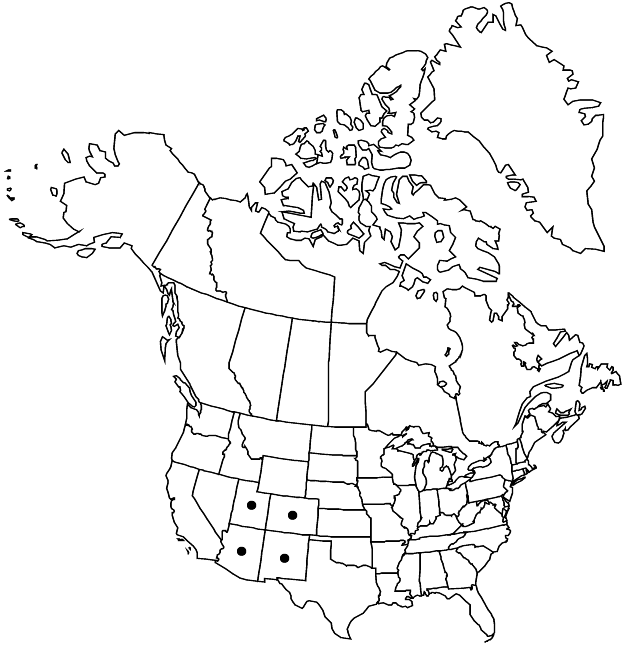Difference between revisions of "Eremogone eastwoodiae var. adenophora"
Sida 21: 240. 2004.
FNA>Volume Importer |
FNA>Volume Importer |
||
| Line 10: | Line 10: | ||
|name=Arenaria eastwoodiae var. adenophora | |name=Arenaria eastwoodiae var. adenophora | ||
|authority=Kearney & Peebles | |authority=Kearney & Peebles | ||
| + | |rank=variety | ||
|publication_title=J. Wash. Acad. Sci. | |publication_title=J. Wash. Acad. Sci. | ||
|publication_place=29: 475. 1939 | |publication_place=29: 475. 1939 | ||
| Line 28: | Line 29: | ||
|elevation=1200-2100 m | |elevation=1200-2100 m | ||
|distribution=Ariz.;Colo.;N.Mex.;Utah. | |distribution=Ariz.;Colo.;N.Mex.;Utah. | ||
| − | |discussion=<p>Variety adenophora is largely restricted to western Colorado, northeastern Arizona, and northwestern New Mexico. The apparent allopatric distributions of the two varieties provide support for the recognition of < | + | |discussion=<p>Variety adenophora is largely restricted to western Colorado, northeastern Arizona, and northwestern New Mexico. The apparent allopatric distributions of the two varieties provide support for the recognition of <i></i>var.<i> adenophora</i>. This is further justified in that the glandular variety abuts the range of the Rocky Mountain <i>Eremogone fendleri</i>. It is assumed that the presence of glandular stems in each of these taxa is of independent origin.</p><!-- |
| − | --><p>Plants of < | + | --><p>Plants of <i></i>var.<i> adenophora</i> may be more likely than those of <i></i>var.<i> eastwoodiae</i> to exhibit pink petals, and they often look smaller, with fewer flowers in a less-open inflorescence. Occasional specimens that we have examined suggest that this taxon may be polyphyletic.</p> |
|tables= | |tables= | ||
|references= | |references= | ||
| Line 38: | Line 39: | ||
-->{{#Taxon: | -->{{#Taxon: | ||
name=Eremogone eastwoodiae var. adenophora | name=Eremogone eastwoodiae var. adenophora | ||
| − | |||
|authority=(Kearney & Peebles) R. L. Hartman & Rabeler | |authority=(Kearney & Peebles) R. L. Hartman & Rabeler | ||
|rank=variety | |rank=variety | ||
| Line 53: | Line 53: | ||
|publication year=2004 | |publication year=2004 | ||
|special status= | |special status= | ||
| − | |source xml=https://jpend@bitbucket.org/aafc-mbb/fna-data-curation.git/src/ | + | |source xml=https://jpend@bitbucket.org/aafc-mbb/fna-data-curation.git/src/f50eec43f223ca0e34566be0b046453a0960e173/coarse_grained_fna_xml/V5/V5_132.xml |
|subfamily=Caryophyllaceae subfam. Alsinoideae | |subfamily=Caryophyllaceae subfam. Alsinoideae | ||
|genus=Eremogone | |genus=Eremogone | ||
Revision as of 21:51, 16 December 2019
Stems stipitate-glandular. Pedicels stipitate-glandular.
Phenology: Flowering late spring–late summer.
Habitat: Dry, stony or sandy hills, mesas, and deserts
Elevation: 1200-2100 m
Distribution

Ariz., Colo., N.Mex., Utah.
Discussion
Variety adenophora is largely restricted to western Colorado, northeastern Arizona, and northwestern New Mexico. The apparent allopatric distributions of the two varieties provide support for the recognition of var. adenophora. This is further justified in that the glandular variety abuts the range of the Rocky Mountain Eremogone fendleri. It is assumed that the presence of glandular stems in each of these taxa is of independent origin.
Plants of var. adenophora may be more likely than those of var. eastwoodiae to exhibit pink petals, and they often look smaller, with fewer flowers in a less-open inflorescence. Occasional specimens that we have examined suggest that this taxon may be polyphyletic.
Selected References
None.